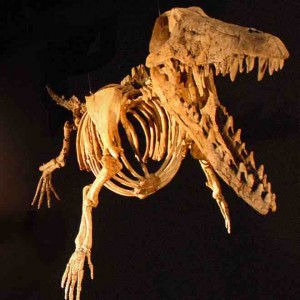
What about evolution? A young mother once asked me, “What should I tell my children about dinosaurs?” This question can be expanded a bit. What should we teach (or allow someone else to teach) our middle school or high school children about the origins of the cosmos, the Earth, and life on our Earth? What our children are taught before they leave high school may strongly influence their relationship to the church and to Jesus as they encounter later science courses along with various worldviews, particularly in college. I maintain that we must always tell our children the truth, including the truth regarding origins. As followers of Jesus who live in the world God created and upholds, we are aware of two sources of knowledge about this very good creation. We read in the Bible about creation, and all of us are aware of at least some aspects of that same creation as understood by natural science. The accounts of creation in these sources do not use the same words and do not have the same overall areas of concern, but we can expect that at least the accounts should not conflict. The book of nature described by science should not contradict the book of nature as read from the Bible. But for the past century and a half, too much conflict has existed.
In this essay I will present a picture of the current scientific status of origins—of cosmic development, the Earth’s origin, and the development of life on our Earth in terms of what is called contemporary cosmology, geo-science, and biological evolution. Included will be the current scientific consensus and notice of unsolved scientific puzzles, followed by a brief discussion of concerns raised by Christian voices. Finally, I will respond to the question raised earlier by the young mother. Before beginning, I should note that this is a daunting topic on which hundreds of thousands of pages have been written. People have spoken, and people have argued. This limited essay will only scratch the surface by providing a brief overview of the topics I have listed. I have provided a book list to guide the reader into more detailed presentations of topics raised in this essay. I am aware that fools go in where angels fear to travel, and admit to being foolish on occasion.
ORIGINS
There are three scientific topics to consider—the origin of the universe, the origin of the Earth, and the origin and development of life on the Earth. Physicists and cosmologists have developed an understanding of the beginnings of the universe for which there is good scientific consensus. The conclusion by cosmologists is that 13.8 billion years ago a cosmic fireball appeared from what seemed to be nothing. In fact, nothing for which we have scientific evidence existed beforehand, not even space or time. These scientists have determined the universe’s age with their estimate of an uncertainty of 0.12 billion years, an uncertainty of less than 1 percent. However, no definitive scientific understanding of the universe exists before the big bang, as there is no way to scientifically explore that era. For the time span just beyond the first fraction of a second after the big bang, cosmologists are confident that they know rather well how the universe developed subsequently, including the formation of our solar system and Earth.
During the course of cosmic advancement, objects on the scale of our solar system formed approximately 5 billion years ago, our planet 4.54 billion years ago (with 1% uncertainty), and complicated molecules on Earth that could self-replicate about 3 billion years ago, according to earth-scientists. How the first self-replicating molecules (meaning molecules associated with life) formed remains an unsolved puzzle. For about a half-century a number of theoretical schemes along with experimental work have been directed toward trying to answering this question, with no clear satisfactory solution as yet.
Scientists who are actively pursuing biological research are confident that for the time period beginning after the appearance of life on Earth, contemporary evolutionary science gives a good account for the development of life up to the present time. Many Christians who conclude that evolutionary science correctly describes how God has brought about and continues to uphold the created order refer to this entire package as evolutionary creation. This is in contrast to evolution advocates who maintain an atheistic religious position. It is important to note that evolutionary science does not imply an atheistic worldview, or for that matter, a theistic worldview. Evolutionary science is neutral or agnostic in regards to metaphysical implications; it is a naturalistic endeavor in scientific method only
and implies no religious or philosophical position. As a result, Christians who find evolutionary science to be an accurate description of how life has developed on Earth are quick to point out that evolution is the mechanism by which God has brought about the wonderfully diverse life we now observe on his Earth, and they maintain that this mechanism is well described by contemporary biological science.
We need to know clearly what we are talking—or arguing—about, so let’s begin with definitions.
(1) Model, theory, and law: Used in a scientific sense, a model is a representation of a certain limited number of scientific facts (scientific data) in terms of some well-understood picture or object. For example, the optical model of the nucleus represents the nucleus of an atom as a partially opaque crystal ball, since there are at least three nuclear phenomena that behave like a beam of light shining on a partially cloudy crystal ball. A scientific model is a first attempt at correlating diverse scientific data with the goal of eventually formulating a higher-level understanding of the phenomena in terms of a theory.
A scientific theory encompasses a more comprehensive set of phenomena than does a model. The scientific use of the term theory does not imply a guess or a scientific shot in the dark. Rather, it is a scientific shorthand designation representing the correlation of a large and diverse set of data related to a broad topic. To designate a scientific description as a theory implies a powerful idea and understanding. Hence, to refer to contemporary neo-Darwinism or evolution as a theory implies that it is the reigning paradigm and undoubtedly the beginning point of any further research in this particular field of study. The theories in physics include the electromagnetic theory by Maxwell (1860s), quantum theory (1930s), relativity theory (early 20th century, Einstein), and in biology the neo-Darwin theory of evolution, each of which gives scientific understanding to a wide swath of phenomena, and each of which is held in high esteem by the scientific community.
The laws of science are short statements that usually refer to a more restricted phenomenon or idea but on which there is universal acceptance. A law summarizes data and many times refers to something that is thought to be invariable. Newton’s law of gravity seems to be without exception. The second law of thermodynamics, when stated correctly, is consistent with all known phenomena. The law of conservation of energy is another example.
As a result, when people ask whether evolution is a fact or only a theory, they display some misunderstanding. The theory of evolution, implying a scientifically comprehensive understanding of a huge and diverse amount of biological data, and not simply a guess or a shot in the dark. Designating the scientific understanding of biological processes as a theory implies that this understanding has a very high vote of confidence with those scientists working to understand these processes. If I ever developed a scientific understanding of the nucleus that is referred to by the nuclear physics community as the Carlson Theory of the Nucleus, I would be very proud and pleased. (I, however, continue to wait.)
In sum, evolutionary theory correlates, systematizes, and interprets an enormous array of biological data (facts) related to the development of life on the Earth into a coherent and small set of principles that account for these data in an elegant way. And this is called the theory of evolution or neo-Darwinism. Biologists working in this field will be greatly surprised if current evolutionary thought is replaced by any scientific theory that is significantly different. Of course, this is entirely possible. No scientific theory is 100 percent certain. It is said of scientists that, if they marry a scientific theory, they may someday find themselves to be a widow or a widower.
(2) Microevolution, macroevolution, theory of evolution, evolutionism, and naturalism: These terms need some clarification. Microevolution and macroevolution are different, but they involve essentially the same processes. Microevolution refers to small changes in species due to the processes of evolution that accumulate over relatively short periods of time (up to a few centuries) within a population. These changes allow a given species to adapt to changes in its environment, and have been observed in numerous instances. Macroevolution is major evolutionary change at the species level or higher, resulting in the formation of new species. In one sense speciation and microevolution are different processes in that speciation often requires the new species to have some type of isolation from its parent group in order to keep the new species distinct. Apart from this, speciation requires no processes other than what is found in microevolution. The theory of evolution is an advanced scientific model, currently at the status of a theory (see the previous discussion of model and theory), whose goal is to explain mechanisms of the development of life on the Earth over a long history, and it does so in terms of common ancestry and descent with change. Evolutionism or naturalism is a philosophical attempt to extrapolate from the scientific theory of evolution to support the atheistic claim that there is no Creator God or any special significance to human life, and therefore no creation of humanity in the image of God. Whereas Christians are divided over whether to support the scientific theory of evolution, no Christian will support the atheistic philosophical system of evolutionism.
EVOLUTIONARY THEORY
Contemporary evolutionary theory encompasses at least the following topics:
- An ancient universe and Earth—measured in billions of years rather than thousands
- First life on Earth
- Natural selection
- Common ancestry and the fossil record—descent with modification
- Biogeography
- Biochemistry and evolution—tracking lineage by tracking genes
- Complexity and self organization
Central to the science of evolution is a great expanse of time. The evolutionary idea of life on Earth developing from the most primitive and simple form to where it is in its magnificent and diverse character throughout our Earth requires time—over hundreds of millions of years, even billions of years. The historical sciences of cosmology and geophysics have used over a dozen independent strategies by which to determine the ages of the universe and Earth. Scientists throughout the world have worked on these problems and have determined both ages with a claimed uncertainty of less than 1 percent. If these results are reliable (and my conclusion is most likely that they are), the bottom line is that the universe and Earth are billions of years old, 13.8 billion years for the universe and 4.5 billion years for the Earth. This means that the expansive timeframe required for the development of life in terms of evolutionary mechanisms is in place.
 MISSING LINKS
MISSING LINKS
The term “missing link” refers to a transitional fossil of any lifeform showing traits of its ancestors and its descendents—an idea informed by Charles Darwin’s evolutionary theories. Pictured is a model of an ambulocetus, Greek for “walking whale.”
The Earth is old enough for a long evolutionary process. But the Earth at its formation was just that—earth (“the dust of the ground” as we read in Genesis 2:7). There was no living thing. How did life begin? Scientists do not know the answer to that question. That is, scientists do not as yet understand how the first life (the first self-replicating molecules) could have been produced by mechanisms that can be understood scientifically. Scientists eschew “god of the gaps” explanations, so are continuing the quest for a scientific understanding (as scientists always do in pursuit of solutions to important unanswered scientific questions.)
Most of what we see or experience can be given a good accounting by science. That does not imply that there can be no religious understanding of those phenomena, for theology answers the why questions whereas science answers the how questions. Hence, even though as followers of Jesus we understand that God created all life, including the first life on Earth, this compliments rather than replaces or invalidates the scientific goal of a scientific accounting for the development of the first life on Earth. In addition, this gap in scientific understanding does not invalidate the remainder of evolutionary thought.
Darwin’s central concept was that of natural selection. The idea is that there is diversity in species, not enough food to go around, and that some organisms do better because they have a more favorable gene pool for their particular environment. Darwin suggested this process of natural selection resulted in the creation of new forms of life from previous ones.
Another fundamental evolutionary concept is that all life, from bacteria to sequoia trees to spiders to grizzly bears to mosquitoes and to humans, developed from a single source. Recent developments in molecular biology have been used to support the proposal that all of life is connected through a common genetic language shared by all living things.
Biogeography is the study of patterns of species distribution across geographical areas and through geological time. Darwin’s observations of finch populations on the Galapagos Islands led to his earliest evolutionary concepts. Modern scientists use biogeographic research to support the idea of common descent.
Before the advent of molecular biology, fossils had been studied for at least 2.5 millennia before the science of paleontology was fully developed in the nineteenth century. Putting together coherent and supportable conclusions from the fossil record is a challenge, because fossils represent only a very small proportion of all the organisms that have ever lived. Fossils only form under specific conditions. Since decomposition is a requirement for environments to remain healthy, fossilization represents a deviation from normal natural processes. Paleontologists conclude that the fossil record provides a strong hint for the idea of the relatedness of all life on Earth. But how complete is the fossil record? Are there “missing links”? The answer given by biologists, Christian or not, is that fossil data shows a clear picture of how creation took place among developing lineages, for example, from dinosaur to modern robin, fish to amphibian, land animals to whale, etc. And more and more such evidence continues to be found in other transitions. In addition to the missing link question, other questions have been raised about the fossil record. What about punctuated equilibrium? the Cambrian explosion? adaptive radiation?
Recently the concept of common ancestry has received a strong piece of supportive evidence from applications of molecular biology to a wide variety of life forms. The evidence has come from studies of the genetic code in the human genome project. Among the significant results from the human genome work it was discovered that all humans worldwide are 99.9 percent identical at the DNA level. Population geneticists conclude that all members of the human species descended from a common set of 10,000 initiators some 100,000 to 150,000 years ago. Furthermore, genome study of other organisms gives support for the idea that all life—humans and all other living things—share a common ancestor.
Question: Are the laws of nature such that biological evolution is limited to small changes in species? Or is it possible that gradual increases in biological complexity can result in the formation of complicated parts of an organism or even a new species? Examples have been observed where living organisms show the ability to self-organize, and there are biological examples where genetic evidence indicates that complexity has developed in an organism. The development of the cosmos and formation of the Earth is understood on the basis of natural processes accounted for by physics, chemistry, and geology. There is no evidence so far that biological development from simple to complex structures or even new structures that self-organize cannot be also understood in terms of natural processes.
The following are a sample of questions that have been posed regarding the scientific status of evolutionary theory, along with brief responses.
(1) Does thermodynamics invalidate evolutionary thought? The second law of thermodynamics states that in a closed system disorder always increases or under ideal conditions stays the same. This is true. But the Earth is not a closed system since it receives energy from the sun. This results in the possibility of life and the development of more and more complex life on Earth. We Earth-dwellers are fortunate because of this.
(2) Does the “Cambrian explosion” pose a challenge to evolution? No. The Cambrian explosion—that is, the “sudden” appearance of animal life about 545 million years ago, including many of the major body plans (called phyla)—occurred over the rather short evolutionary time of 20 million years, maybe a bit less. But this time span is not too short for the process of evolution. The causes of the Cambrian explosion remain a topic of investigation and discussion.
(3) Can evolution account for the complexity of life on Earth? Yes, this is possible. The key idea is self-organization and is understood in terms of a fairly recent development in the physics of thermodynamics, that of non-equilibrium thermodynamics. The question of how complex biological structures could be the result of natural processes has been investigated, and the assembly or development of several such structures can be understood in terms of these scientific principles.
(4) Are evolutionary processes random and blind, so that humanity is simply a lucky outcome? A case can now be made that evolution is a process that leads to a defined result, that evolution is convergent, and that the development of sentient creative life was inevitable. Christian evolutionary biologists refer to this as evolutionary creation. Hence, contrary to certain atheistic biologists, other biologists maintain that evolution is not to be associated with blind random chance.
(5) But isn’t the origin of life highly improbable? Yes. The development of the first life on Earth is and was highly improbable, and scientists still cannot satisfactorily account for its beginning. Christians will rightly say that God created the first life and, in fact, all life. And God through Christ continues to actively uphold the universe. For the Christian who accepts evolutionary science, the implication is that God has been and continues to be involved in the entire process of evolution. But the issue here is that scientists want to account for the first life in terms of science, and that has as yet not been accomplished.
To be sure, there is more work to be done. Yet almost all biological scientists find the evidence in support of the contemporary scientific theory of evolution quite compelling. Perhaps the most convincing piece of evidence comes from biochemistry, for here these scientists find evidence for confirmation of the picture that emerged from Darwin’s work and developed for a century and a half before the work on the genome. In a sense these scientists say that they could hardly ask for a more convincing test and striking confirmation of a scientific theory. Virtually all scientists conduct evolutionary-related research within the contemporary scientific evolutionary paradigm. This is true whether they are Christians—followers of Jesus—or non-Christians. Evolutionary theory is the starting point for all, for at this time there is no other scientific game in town that challenges evolution.

“If scientifically informed voices are ejected from our conservative religious communities, those communities will become even more intellectually impoverished. I suspect this is behind the bad news in the latest Gallup poll on origins. Clearly, we need new strategies for engaging churches in conversation about science and Scripture.”
+ Karl Giberson, reflecting on recent Gallup polls on faith and science and three congregational case studies. Read more here.
CHRISTIANS AND EVOLUTIONARY SCIENCE
So, how does this leave the Christian believer in terms of relating evolutionary science to Christian faith? Can there be peace? Let me suggest a modest peace plan.
- Science and its spokespeople, speaking for science, should stick to science and not claim that evolutionary science demonstrates that God does not exist.
- Scientists must do competent and honest science.
- Christians must also be honest—and those with experience in science must honestly evaluate scientific evidence.
- Christians should do competent Bible study—carefully considering what the creation passages in the Bible teach, what they taught the ancient original hearers/readers, and what they mean for us today. This will require careful and thoughtful study.
Science done properly is agnostic regarding meta-science. Its methods are naturalistic—that is, science asks how in terms of laboratory investigations. Its data are numbers and diagrams. It cannot address the why questions of theology. Science is a limited enterprise. The science that has been discussed in this essay implies nothing in terms of purpose or whether there is evidence for or against the existence of God. There is nothing anti-God or anti-Christian about evolutionary science. Such questions are not the purview or interest of science.
Is evolution consistent with Christian thought as found in Genesis, particularly the first creation account in Genesis 1:1–2:3? This is a legitimate question. Genesis 1 sets forth a six-day creation event. Each creation event is an instantaneous creation, in contrast with the scientific picture of development over billions of years. Genesis 2 contains a second narrative of creation and relates a one-day creation. How do we reconcile the two biblical creation narratives with contemporary science? Should we adjust science to conform to what we read in Genesis? If so, which account in Genesis? Or can we think of faithfully reading Genesis 1 and 2 in a way that does not require the scientific data of these creation accounts to conform to twenty-first-century science? Perhaps we could look for some meaning in these creation accounts that does not center on science as science, and in particular try to understand Genesis as the original author intended his readers (hearers) to understand his message in their ancient Near East context. The usefulness of the cosmological, geological, and biological data discussed in this essay may simply be to put some interpretive fences around the creation accounts in Genesis. I maintain that these Genesis creation accounts are true and as 2 Timothy 3:16 states, are intended to teach us what is true. But what is true for us as twenty-first-century readers may not necessarily be the ancient science in the accounts, but something much more important—the worldview of the ancient Hebrews. If that was the intent of the sacred biblical author, then there is no conflict between contemporary science and our Bible. God indeed created, but Genesis 1 and 2 may not exist for the purpose of a science lesson, but rather for a much more important purpose. Genesis tells us of a people God set aside to bless all nations, and through the creation accounts we learn of the basic outlook this people had because of their relationship to God. The bottom line is that the Bible is true, but we need to carefully read Genesis from the viewpoint of its ancient Near Eastern context and then ask how this might be appropriated within our own context.
What should we tell our children about dinosaurs? We must tell them the truth. It is our responsibility to do our best to determine what that truth is. We must not set up our children for confusion and disillusionment when they hear the scientific story from high school teachers and college professors. I have told my children that it is highly likely that dinosaurs lived on our Earth millions of years ago, went extinct over 60 million years ago, and are a wonderful part of God’s marvelous creation.

